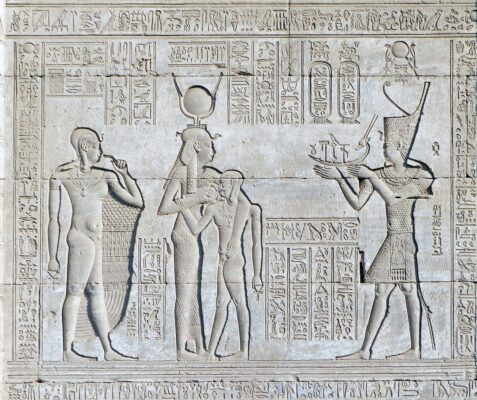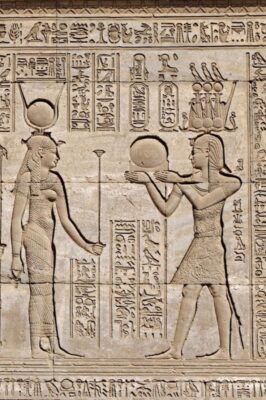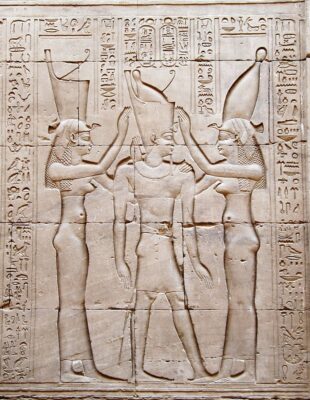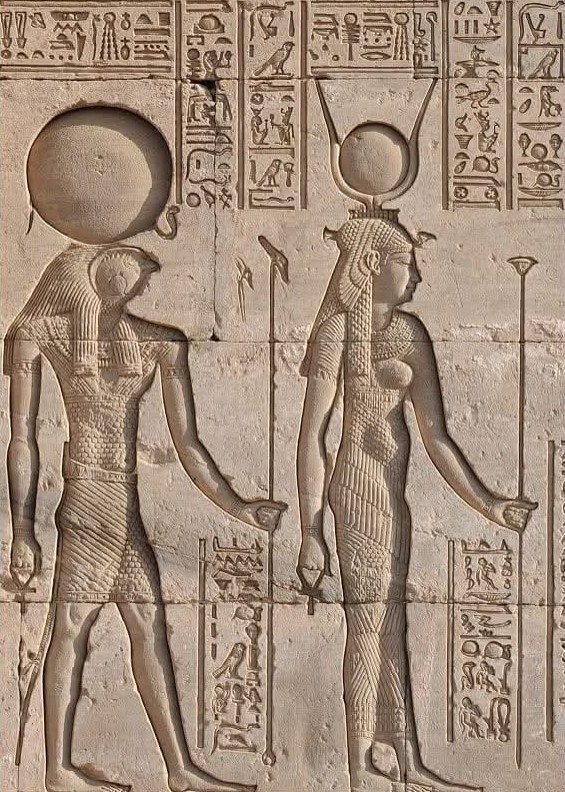In ancient Egyptian mythology, Ra and Hathor were two of the most powerful and revered deities. Their roles in Egyptian culture, religion, and cosmology were of immense importance, symbolizing both the life-giving power of the sun and the nurturing aspects of love, fertility, and joy. Understanding their roles provides a deeper insight into the rich tapestry of Egyptian mythology. Follow archeology.dulichvn.net to discover many hidden mysteries that have yet to be discovered.

Ra: The Sun God and Creator
Ra was the supreme god in the ancient Egyptian pantheon, often referred to as the Sun God. His power was considered unparalleled, and he played a central role in the creation of the world and the ongoing cycle of life.
The Central Role of Ra in Egyptian Cosmology
Ra held an unparalleled position in ancient Egyptian culture, revered as the creator god who brought life to the world. His power was inextricably tied to the sun, with the Egyptians believing that Ra’s daily journey across the sky governed the rhythms of life itself. Each day, Ra embarked on a voyage across the heavens in his solar barque, bringing light to the earth as he rose in the east. As night fell, Ra descended into the underworld, symbolizing the cycle of life, death, and rebirth that defined the universe. This cyclical journey of Ra was not only a physical phenomenon but a spiritual one, encapsulating the eternal flow of time and the divine order of existence.
Ra’s Depictions in Art and Mythology
In Egyptian art, Ra is often portrayed as a man with the head of a falcon, a powerful symbol of his rule over the skies. Above his head, the solar disk, often encircled by a serpent, is a direct representation of his divine association with the sun.
This iconic image conveys both Ra’s strength and his supreme authority, underscoring his role as the ruler of both the celestial and earthly realms. His representation in Egyptian art emphasizes the idea of cosmic order, with the sun not just as a source of light, but as a symbol of Ra’s unyielding power and dominion over all creation. This depiction reinforced his role as the divine lawgiver, ensuring the balance and harmony of the world.
Ra’s Profound Influence on Egyptian Society
Ra’s impact reached far beyond the realms of mythology, deeply influencing every aspect of Egyptian society. Pharaohs, regarded as the living embodiment of Ra on earth, were entrusted with the sacred duty of upholding maat—an ancient Egyptian concept of truth, order, and cosmic balance. The daily cycle of the sun rising and setting served as a constant reminder of the unchanging laws of the universe, reinforcing the belief that order and harmony must be maintained in both the natural world and society.
The pharaohs’ connection to Ra symbolized their role in preserving this balance, with their authority being derived directly from the sun god. This divine mandate ensured the continuity of Egypt’s civilization, embedding Ra’s influence into the very fabric of Egyptian culture, governance, and religion.

Hathor: The Goddess of Love and Joy
While Ra symbolized power, creation, and the unyielding force of the sun, Hathor embodied love, fertility, and the nurturing aspects of life. Hathor’s role in Egyptian mythology was essential to the balance of life and death, serving as the goddess of love, music, dance, and motherhood.
Hathor’s Iconography and Symbolism
Hathor’s depictions in ancient Egyptian art were rich with symbolism, reflecting her dual role as both a nurturing and powerful deity. She was frequently shown as a cow, symbolizing fertility, nourishment, and maternal care. In other representations, Hathor was depicted as a woman with cow’s horns, often cradling a solar disk, symbolizing her intimate connection with the sun and its life-giving energy.
This powerful combination of femininity and strength embodied Hathor’s protective nature and her role as a provider. Additionally, Hathor was often shown holding a scepter or a mirror—symbols of her association with beauty, abundance, and the joy of life. These images reinforced her status as the goddess of love, music, dance, and happiness.
Hathor’s Impact on Egyptian Culture
Hathor’s influence was pervasive across Egyptian society, especially in areas related to love, beauty, and fertility. Women invoked Hathor’s blessings during childbirth, seeking her protection and assistance in ensuring the health and well-being of both mother and child.
Her connection to joy and celebration was also central to Egyptian culture, as music, dance, and festivity were integral to daily life. Hathor’s role as a goddess of joy was reflected in her association with music and dance, two elements of Egyptian rituals and social gatherings. Beyond personal aspects of fertility and protection, Hathor was also revered as a goddess of maternal care, looking after both individuals and the larger community. Her compassionate nature made her a deity of great importance to all Egyptians, from the common folk to the royal family.
Hathor’s Relationships with Other Deities
While Hathor was an influential goddess in her own right, her relationships with other deities further cemented her significance in the Egyptian pantheon. She was often associated with Ra, the sun god, and in some myths, she was described as his daughter. This familial connection between Hathor and Ra reflected the deep bond between the forces of the sun and fertility. Hathor was also linked to Horus, the falcon-headed god of kingship, and she played a role as either his mother or consort in various myths.
Hathor’s ties to these powerful gods highlighted her multifaceted role within the Egyptian belief system. She was not just a goddess of love and beauty, but also a divine force who supported and nurtured the cosmic balance, making her one of the most revered and influential deities in Egyptian mythology.

The Relationship Between Ra and Hathor
Ra and Hathor, despite their different domains, represented complementary forces within the Egyptian mythological system. Their relationship embodies the balance between creation and protection, power and nurturing.
Ra and Hathor: A Harmonious Cosmic Balance
Ra, as the sun god, represented the life-giving energy and vitality of the sun, providing light, power, and creation. In contrast, Hathor, with her nurturing qualities, balanced this force with warmth, protection, and sustenance. Together, they exemplified the harmonious interplay of active and passive forces in the cosmos. Ra’s solar power and Hathor’s nurturing influence were essential to the natural cycles, ensuring the balance between life’s creation and preservation. This complementary dynamic highlights how the ancient Egyptians understood the delicate equilibrium between creation and sustenance, a concept that was central to their worldview.
Hathor as the Eye of Ra
In various myths, Hathor is depicted as the “Eye of Ra,” a powerful, protective force that took the form of a lioness. This role emphasizes Hathor’s fierce and protective side, showcasing her strength as a guardian of the divine. As the Eye of Ra, she would defend him from any threats, embodying both nurturing and warrior-like qualities. Hathor’s transformation into a lioness also underlined her protective nature, reinforcing that she was not only the goddess of love and fertility but also a fierce defender of order and balance. In this myth, Ra and Hathor’s partnership becomes even more profound, as they worked together to maintain cosmic harmony and safeguard the world from chaos.
The Sacred Union of Ra and Hathor
The union of Ra and Hathor represents a divine balance of masculine and feminine energies, symbolizing the complete spectrum of existence in ancient Egyptian thought. Ra’s commanding presence as the sun god and Hathor’s life-affirming, nurturing qualities formed a powerful partnership, where their complementary forces created and sustained the world.
This divine connection reveals that the gods were not isolated in their powers but were interconnected, each influencing the others to maintain the natural and cosmic order. The harmony between Ra and Hathor embodies the ancient Egyptian belief that creation and preservation must coexist in unity, allowing the world to flourish and endure.
See more: The Karakoram Highway: An Engineering Marvel Connecting Pakistan and China
Conclusion
Ra and Hathor stand as two of the most prominent and influential deities in Egyptian mythology. While Ra’s solar power and creation myths emphasized his dominion over the world and the heavens, Hathor’s nurturing nature balanced this force with love, fertility, and protection.
Their intertwined relationship represented the essential harmony of opposites that was a key concept in Egyptian belief, illustrating how the balance between strength and compassion, power and care, was central to the functioning of the universe. Together, Ra and Hathor formed a divine pair whose influence extended far beyond myth, leaving a lasting legacy in Egyptian culture, religion, and art.


CÁC TIN KHÁC
Mary Walton: The Forgotten Inventor Who Helped Clean Up America’s Cities
Tomb of Queen Nefertari in the Valley of the Queens, Egypt
Discover the Hypostyle Hall of the Temple of Hathor at Dendera
Venus de Losange: Unveiling the Mystery of a 20,000-Year-Old Paleolithic Icon